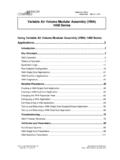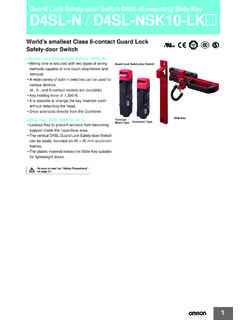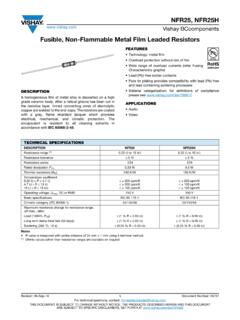Transcription of SUPPORTING STUDENTS WITH WORKING …
1 SUPPORTING STUDENTS WITH. WORKING memory DIFFICULTIES. No matter how motivated you are, it is hard to learn and retrieve key knowledge and skills if you can only hold on to a limited amount of information in memory at one time. WORKING memory is an executive function that allows us to hold information in mind while WORKING with it. WORKING memory is critical in the process of storing information in long-term memory . It is also critical in retrieving previously learned information from memory . In fact, most of the work in the memory system occurs in WORKING memory where information is managed, manipulated and transformed. WORKING memory capacity differs from individual to individual. STUDENTS with WORKING memory difficulties can hold fewer pieces of discrete information in their mind at any given moment. They hear what you said, or see what is presented, but as more information overwhelms their memory system they lose previous information needed to successfully complete the task.
2 Once information is lost it is not likely to be retrieved. It is easy to see how the student can become frustrated and consequently stop paying attention. WORKING memory difficulties are common among STUDENTS with Attention Deficit/Hyperactivity Disorder (AD/HD), learning disabilities, hearing loss, acquired brain injury and mental health issues. What WORKING memory Difficulties Might Look Like STUDENTS may: Have difficulty remembering facts and procedures, such as new vocabulary words, verb conjugations or mathematical procedures. Exhibit slow retrieval of information. Fail to follow instructions despite repeated instructions. Demonstrate poor attention to detail, such as beginning to write a sentence and then struggling to remember all of the words in the sentence, skipping words within sentences, and writing shorter sentences (to reduce demands on WORKING memory ). Make place-keeping errors such as losing track of steps completed or steps yet to be completed and either repeats steps needlessly or constantly has to start over.
3 Have difficulty starting work. Demonstrate difficulty staying on task. Task abandonment is a common consequence. Lose track of belongings. These difficulties have a negative impact on core academic skills of reading, writing and mathematics. They may in turn affect performance in all subject areas. Take Ten series | CanLearn Society - 2013 1 of 9. Strategies WHAT CAN BE DONE? Currently, we do not have easy approaches to build WORKING memory skills. Skill building does not generalize well to classroom performance. However, there are ways to support STUDENTS that will help them compensate for WORKING memory difficulties. MONITOR THE STUDENT. Ask the student to verbalize their steps in completing tasks they often struggle to complete. This can provide important information about where the breakdown is occurring and what supports are likely to work best. Evaluate the WORKING memory demands of learning activities.
4 A student with WORKING memory difficulties will need more support as tasks get longer, become more complex, have unfamiliar content or demand more mental processing. REDUCE THE memory LOAD. Break tasks into smaller chunks. One task at a time is best, if possible. Reduce the amount of material the student is expected to complete. Keep new information or instructions brief and to the point, and repeat in concise fashion for the student, as needed. Provide written directions for reference. Simplify the amount of mental processing required by providing several oral clues for a problem and writing key words for each clue on the board or interactive whiteboard. This way the student does not have to hold all of the information in mind at once. Increase the meaningfulness of the material by providing examples STUDENTS can relate to. Provide information in multiple ways: speak it, show it, and create opportunities to physically work with it or model it.
5 Develop routines, such as specific procedures for turning in completed assignments. Once a routine is practiced repeatedly, it becomes automatic and reduces the WORKING memory demand. Take Ten series | CanLearn Society - 2013 2 of 9. REPEAT AND REVIEW. Be prepared to repeat information. Use visual reminders of the steps needed to complete a task. Provide opportunities to repeat the task. Encourage practice to increase the amount of information encoded into memory . Teach STUDENTS to practice in short sessions, repeatedly throughout the day. Spaced practice is more effective than massed practice. Have STUDENTS practice new skills or information in short sessions over the course of the day rather than in one long session. For example, give the student a set of key facts to review for a few minutes two or three times during the school day, and encourage them to review again at home both at night and in the morning.
6 USE ADVANCE ORGANIZERS. Use advance organizers and teach STUDENTS how to use them. For example, KWL (What I Know, What I. Want to Know, What I Learned) is a graphic organizer that helps STUDENTS focus on what is to be learned. This tool activates prior knowledge, helps generate questions to explore and then assists STUDENTS to connect what they learn to what they already know. TEACH STEP-BY-STEP STRATEGIES. Teach one strategy at a time in brief, focused sessions. Teach STUDENTS when, where, why and how to use the strategy. Include the following steps in teaching a strategy: Review and activate prior knowledge. Encourage use and practice. Be overt and explicit. Evaluate and recognize effort and success. Model and think aloud. Encourage self-monitoring. Have skilled STUDENTS model steps. Promote transfer to other situations, times, activities and groups. Take Ten series | CanLearn Society - 2013 3 of 9. ENCOURAGE THE USE OF memory AIDS.
7 Use visual posters, of multiplication tables. Create posters of commonly used words. Provide instructions in written form could be a handout, whiteboard, or simply a sticky note. Provide a key word outline to refer to while you are teaching. Encourage the use of checklists for multi-step tasks ( , steps for editing written work, timelines for assignments). Encourage STUDENTS to make lists of reminders regularly. Use graphic organizers to teach new concepts and information. When the student can picture how the ideas are interrelated, they can be stored and retrieved more easily. Consider educational technology that reduces the demand on WORKING memory , such as calculators, word processors, spell-check devices, grammar-check devices, and voice dictation and text readers. Use rhymes, songs, movements and patterns, such as '30 days hath September' rhyme for remembering the number of days in each calendar month. Music and physical routines linked to fact learning can help STUDENTS memorize faster and act as a cue for retrieving specific information.
8 PAUSE, PARAPHRASE, SUMMARIZE AND ALLOW TIME. Stop at least two times per lesson and request a quick summary from STUDENTS what have we learned so far? followed by quick notes on the board. Research overwhelmingly indicates that at least 40% of total learning time needs to be spent reviewing new material. Request STUDENTS to paraphrase, or have another student paraphrase verbally delivered directions. Research has repeatedly shown that youth are more likely to hear and remember if they hear their own voice or a peer's voice. Allow time for rehearsal and processing. Allow extra time for the student to retrieve information. These STUDENTS benefit from advance warning that they will be asked a question. Avoid open-ended questions. GET PHYSICAL. Active participation with the material such as repeatedly hearing it, seeing it and moving it, holds the information in WORKING memory so it can move to long-term memory . Let the STUDENTS move around, use hands-on material and put information on file cards so they can be manipulated.
9 Wherever possible, use games such as Jeopardy and Scrabble , drama and art to reinforce concepts. Take Ten series | CanLearn Society - 2013 4 of 9. COLOUR CODE. Physical coding, such as consistent colours for different subject areas, can act as triggers to help STUDENTS remember information. oo Try coding when teaching new concepts: when teaching sentence structure nouns are always red, verbs are always green etc. oo Spelling highlight difficult parts of new words. oo Vocabulary teach new words in categories or families and colour code the categories. oo Encourage the use of coloured pens or highlighters (remember, yellow is the LEAST effective). MAKE OVERT LINKS. Try to get the STUDENTS to link new information to prior knowledge encourage drawing, writing and verbal reflection. The use metaphors, analogies, imagery or induced imagery (where the image is generated by the individual, rather than given to them) can help.
10 Start each lesson with a quick review of the previous lesson always write down key words as the STUDENTS recall information to model trigger words . End each lesson with a summary of what was learned. KEY WORDS. Teach STUDENTS to listen for key words. Post the words in the classroom and frequently use them as cues while you teach. Often STUDENTS with WORKING memory difficulties also exhibit word and information retrieval difficulties. They frequently experience the tip of the tongue phenomenon, or may produce the wrong details within the correct concept. The student may need additional time to retrieve details when answering a question. Cues may be necessary to help them focus on the correct bit of information or word. Take Ten series | CanLearn Society - 2013 5 of 9. TEST TAKING. Allow extra time, or reduce the number of questions. Consider requiring recognition vs. recall. Teach STUDENTS to scan the test and plan their time allocation.








